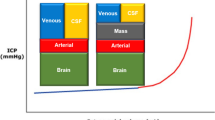Abstract
Purpose
Management of cerebral edema in infants is challenging. Decompressive craniectomy in young age has shown favorable outcomes for management of intracranial hypertension, but current literature is scarce and consists of only case reports or small series. The purpose of the current study is to report the challenges faced with this procedure and its complications in this peculiar age group.
Methods
This is a retrospective chart review of infants (less than 1 year of age) undergoing unilateral or bilateral decompressive craniotomy at a tertiary care hospital in Pakistan. Kochi score was used to score outcomes of five infants who underwent the procedure.
Results
Five infants were included in this series. Operative time for decompressive craniectomy (DC) ranged from 1 h and 40 min to 4 h. Three infants survived to undergo cranioplasty. Two infants recovered with good Kochi scores of 5a and one infant developed hemiparesis (Kochi score 3b).
Conclusions
Decompressive craniectomy carries good outcomes in selected patients. Risk of bleeding and hemodynamic instability makes this procedure challenging. We found coagulopathy in four of the five patients which poses another challenge to the surgical management of these patients and has not been stressed enough in the previous literature.



Similar content being viewed by others
References
Adamo MA, Drazin D, Waldman JB (2009) Decompressive craniectomy and postoperative complication management in infants and toddlers with severe traumatic brain injuries. J Neurosurg Pediatr 3(4):334–339
Stricker P, Shaw T, Desouza D, Hernandes S, Bartlett S, Friedman D, et al. (2010) Blood loss, replacement, and associated morbidity in infants and children undergoing craniofacial surgery. Pediatr Anesth 20(2):150–159
Yamaura A, Sato M, Meguro K, Nakamura T, Uemura K (1977) Cranioplasty following decompressive craniectomy—analysis of 300 cases. No Shinkei Geka 5:345–353
Chiaretti A, Piastra M, Pulitano S (2002) Prognostic factors and outcome of children with severe head injury: an 8-year experience. Childs Nerv Syst 18:129–136
Güresir E, Schuss P, Seifert V, Vatter H (2012) Decompressive craniectomy in children. Single-center series and systematic review. Neurosurgery 70(4):881–889
Ruf B et al (2003) Early decompressive craniectomy and duraplasty for refractory intracranial hypertension in children: results of a pilot study. Crit Care 7(6):R133
Suárez E, González A, Díaz C, Salido A, de Azagra Garde A, Flores J (2011) Decompressive craniectomy in 14 children with severe head injury: clinical results with long-term follow-up and review of the literature. J Trauma: Inj Infect Crit Care 71(1):133–140
Kan P et al. (2006) Outcomes after decompressive craniectomy for severe traumatic brain injury in children. J Neurosurg Pediatr 105(5):337–342
Jagannathan J, Okonkwo D, Dumont A, Ahmed H, Bahari A, Prevedello D, Jane J, Jane J (2007) Outcome following decompressive craniectomy in children with severe traumatic brain injury: a 10-year single-center experience with long-term follow up. J Neurosurg Pediatr 106(4):268–275
Frassanito P, Massimi L, Caldarelli M, Tamburrini G, Di Rocco C (2012) Complications of delayed cranial repair after decompressive craniectomy in children less than 1 year old. Acta Neurochir 154(5):927–933
Harhangi B, Kompanje E, Leebeek F, Maas A (2008) Coagulation disorders after traumatic brain injury. Acta Neurochir 150(2):165–175
Yang XF et al. (2008) Surgical complications secondary to decompressive craniectomy in patients with a head injury: a series of 108 consecutive cases. Acta Neurochir 150(12):1241–1248
Peiniger S et al. (2012) Glasgow coma scale as a predictor for hemocoagulative disorders after blunt pediatric traumatic brain injury*. Pediatr Crit Care Med 13(4):455–460
Whittaker B et al. (2013) Early coagulopathy is an independent predictor of mortality in children after severe trauma. Shock 39(5):421–426
Conflict of interest
We have no affiliations with or involvement in any organization or entity with any financial interest, or non-financial interest, in the subject matter or materials discussed in this article.
Author information
Authors and Affiliations
Corresponding author
Rights and permissions
About this article
Cite this article
Riyaz, M., Waqas, M., Ujjan, B.U. et al. Decompressive craniectomy for infants: a case series of five patients. Childs Nerv Syst 31, 2117–2122 (2015). https://doi.org/10.1007/s00381-015-2808-1
Received:
Accepted:
Published:
Issue Date:
DOI: https://doi.org/10.1007/s00381-015-2808-1




